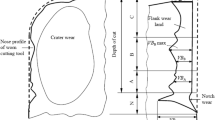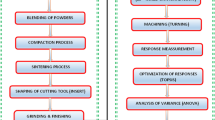Abstract
Turning of 7075 Al alloy reinforced with SiC particulates was done on CNC machine by using tungsten carbide tools. Experimental were planned as per face centered central composite design (FCCCD). Response surface methodology (RSM) was utilized for modeling impact of parameters viz. cutting speed, feed, depth of cut and nose radius on responses viz. surface roughness and tool life. Single objective optimization for surface roughness and tool life was carried out. To obtain balance between surface roughness and tool life, a system for concurrent optimization of several objectives founded on an overall desirability function was utilized. Multi response optimization provided cutting speed of 90 m/min, feed of 0.15 mm/rev, depth of cut of 0.20 mm and nose radius of 0.68 mm. turning at these conditions will result in lowest surface roughness and maximum tool life. Which signify a satisfactory whole desirability. Components of AA7075/ SiC composite are being used in automobiles, ships, aero planes due to their high specific strength and wear resistance. Machining of AA7075/10 wt.% SiC (10-20 μm) composites is still a challenge due to poor surface roughness and high tool wear. Novelty of this work is that values of parameters to simultaneously achieve minimum surface roughness and maximum tool life was obtained by multi response optimization of process parameters. Very little research is available on this issue in literature.
Similar content being viewed by others
References
Palanikumar K, Karthikeyan R (2007) Optimal machining conditions for turning of particulate metal matrix composites using Taguchi and response surface methodologies. Machining Science and Technology 10:417–433
Nalbant M, Gökkaya H, Sur G (2007) Application of Taguchi method in the optimization of cutting parameters for surface roughness in turning. Materials and Design 28:1379–1385
Das P, Mukherjee S, Ganguly S, Bhattacharyay BK, Datta S (2009) Genetic algorithm based optimization for multi-physical properties of HSLA steel through hybridization of neural network and desirability function. Computational Materials Science 45(1):104–110
Kremer A, Devillez A, Dominiak S, Dudzinski D, El Mansori M (2008) Machinability of Ai/Sic Particulate Metal-Matrix Composites under Dry Conditions with CVD Diamond-Coated Carbide Tools. Machining Science and Technology 12:214–233
Sadat AB (2009) On the Quality of Machined Surface Region When Turning Al/Sic Metal Matrix Composites. Machining Science and Technology 13:338–355
Asilturk I, Akkus H (2011) Determining the effect of cutting parameters on surface roughness in hard turning using the Taguchi method. Measurement 44:1697–1704
Arun Premnath A, Alwarsamy T, Rajmohan T (2012) Experimental Investigation and Optimization of Process Parameters in Milling of Hybrid Metal Matrix Composites. Materials and Manufacturing Processes 27:1035–1044
Sahoo AK, Pradhan S, Rout AK (2013) Development and machinability assessment in turning Al/SiCp-metal matrix composite with multilayer coated carbide insert using Taguchi and statistical techniques. Archives of civil and mechanical engineering 13:27–35
Johanssona D, Hägglund S, Bushlya V, Ståhl J-E (2017) Assessment of Commonly Used Tool Life Models in Metal Cutting. Procedia Manufacturing 11:602–609
Sahithi VVD, Malayadri T, Srilatha N (2019) Optimization Of Turning Parameters On Surface Roughness Based On Taguchi Technique. Materials Today: Proceedings 18(Part 7):3657–3666
Grum J, Slab JM (2004) The use of factorial design and response surface methodology for fast determination of optimal heat treatment conditions of different Ni-Co-Mo surface layers. Journal of material processing technology 155–156:2026–2032
Oktem H, Erzurmlu T, Kurtaran H (2005) Application of response surface methodology in the optimization of cutting conditions for surface roughness. Journal of material processing technology 170:11–16
Montgomery DC (2001) Design and Analysis of experiment5th edn. Wiley, New York
Jinshan L, Cuiqing YM, Yan L, Wei Z, Ping X (2007) Medium optimization by combination of response surface methodology and desirability function: An application in glutamine production. International Journal of Advanced Manufacturing Technology 74:563–571
Dhupal D, Doloi R, Bhattacharyya B (2008) Parametric analysis and optimization of Nd: YAG laser micro-grooving of aluminium titanate (Al2TiO5) ceramics. International Journal of Advanced Manufacturing Technology 36(9–10):883–893
Bhushan RK, Kumar S, Das S (2010) Effect of Machining Parameters on Surface Roughness and Tool Wear for 7075 Al Alloy SiC Composite. The International Journal of Advanced Manufacturing Technology 50(5–8):459–469
Author information
Authors and Affiliations
Corresponding author
Additional information
Publisher’s Note
Springer Nature remains neutral with regard to jurisdictional claims in published maps and institutional affiliations.
Rights and permissions
About this article
Cite this article
Bhushan, R.K. Multi-Response Optimization of Parameters during Turning of AA7075/ SiC Composite for Minimum Surface Roughness and Maximum Tool Life. Silicon 13, 2845–2856 (2021). https://doi.org/10.1007/s12633-020-00640-w
Received:
Accepted:
Published:
Issue Date:
DOI: https://doi.org/10.1007/s12633-020-00640-w




